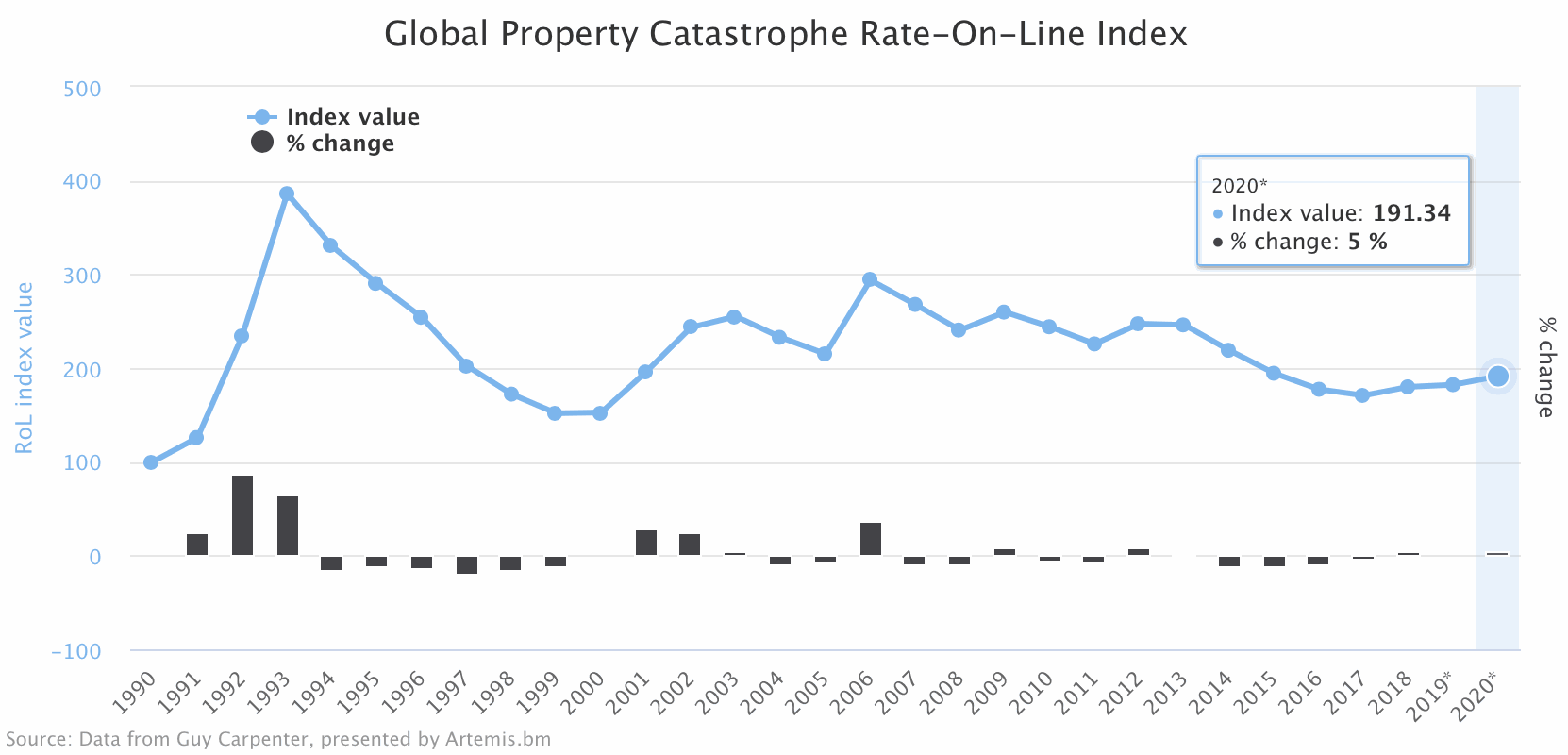Global property catastrophe reinsurance rates have risen at the renewals, according to broker Guy Carpenter, who said that its Global Property Catastrophe Rate-On-Line Index has risen by 5% at 1/1 2020.
As ever, opinions differ amongst reinsurance brokers, but in the main the pricing reports coming out of renewal communications are so far relatively aligned, in that property catastrophe reinsurance was in general flat to slightly up, with severely loss affected accounts experiencing higher price increases.
Guy Carpenter’s analysis also reflects this and the brokers Index demonstrates that the market in general moved up, albeit not at the rate many had likely been hoping to see.
The Global Property Catastrophe Rate-On-Line Index is a proprietary index of global property catastrophe reinsurance Rate-on-Line movements, for brokered excess of loss placements, that has been maintained by Guy Carpenter since 1990.
This Index has risen by 5% January 1st 2020, reflecting the price increases achieved by reinsurers at renewals.
This is a more significant move than seen a year ago, when the Index only rose by just over 1%, but lower than seen at the January 2018 renewals, when the Index rose by 5.3%.
The good news for reinsurers and ILS funds though, is that the Index is now closing on levels last seen in 2015 and also that the uptick in the Index in recent years does look relatively stable at this time.
Guy Carpenter explained that the property catastrophe reinsurance market saw some “significant” price adjustments for loss-impacted programs in peak zones, whereas loss-free accounts in other geographies actually trended flat to down.
With this Index weighted towards peak zone perils at the January renewals, the slight rise seems to have been driven more by the loss impacted accounts, than the market as a whole and certainly does away with the idea that the market is broadly harder after this renewal.
The broker said that the renewal was shaped by deteriorating loss experience, a lack of new capital inflows and also increasingly challenged primary insurance and retrocession markets.
While reinsurance supply was seen as in the main sufficient to meet increasing demand, apart from in some of the most constrained areas of the market, Guy Carpenter said that renewal outcomes have varied significantly by geography, line of business and cedent, with their performance one of the key differentiators.
Losses and the changing view of risk has been a particular driver for this renewal, the broker said, with reassessments of risk resulting in some drawbacks of capacity after derisking exercises or complete withdrawals of capacity.
Guy Carpenter calls the January 2020 renewal market “asymmetrical”, as certain classes whose performance remained positive and profitable often resulted in flat renewals, or in some cases a modest rate decrease.
Conversely, the areas of the market that have been more strained saw market corrections, some significant.
The most pronounced reinsurance rate increases were locally felt in specific regions or markets, Guy Carpenter explained, driven mainly by successive years of losses, deterioration in performance and changing perceptions of risk.
“The (re)insurance sector is undergoing a period of transition as risk quantification strategies incorporate new information and risk appetites are adjusting accordingly,” explained Peter Hearn, President and Chief Executive Officer of Guy Carpenter.
“The response of the reinsurance market to these dynamics continues to evolve. At January 1, 2020, there was more than sufficient capital relative to demand for most renewal placements, even as reinsurers navigated elevated losses and adjusted underwriting assumptions to reflect changing perceptions of risk. However, market conditions have clearly tightened and negotiations became a function more of price than capacity,” Hearn continued.
David Priebe, Chairman of Guy Carpenter, also said, “The reinsurance market enters 2020 in a solid position with initial analysis of dedicated reinsurance capital up slightly as compared to a year ago, bolstered by mid-single digit growth in rated capital in 2019. Accounting for the impact of trapped capital, total available capital at January 1 is close to flat. While reinsurers will continue to deploy capacity cautiously, with cedents’ performance and loss experiences scrutinized closely, the sector remains well capitalized overall.”
You can track Guy Carpenter’s Global Property Catastrophe Rate-On-Line Index here on Artemis, as well as the brokers U.S. Property Catastrophe Rate-On-Line Index and Regional Property Catastrophe Rate-On-Line Index.
Read all of our reinsurance renewal coverage here.
Make sure you register soon for our ILS NYC 2020 conference, as tickets are selling fast!
 View all of our Artemis Live video interviews and subscribe to our podcast.
View all of our Artemis Live video interviews and subscribe to our podcast.
All of our Artemis Live insurance-linked securities (ILS), catastrophe bonds and reinsurance video content and video interviews can be accessed online.
Our Artemis Live podcast can be subscribed to using the typical podcast services providers, including Apple, Google, Spotify and more.
































